Easing-in and easing-out clips
Ease-in and ease-out a clip to create a smooth transition between a clip and its surrounding gaps. To create an ease-in or ease-out transition, select a clip and, in the InspectorA Unity window that displays information about the currently selected GameObject, Asset or Project Settings, allowing you to inspect and edit the values. More info
See in Glossary window, set either the Ease In Duration or the Ease Out Duration.
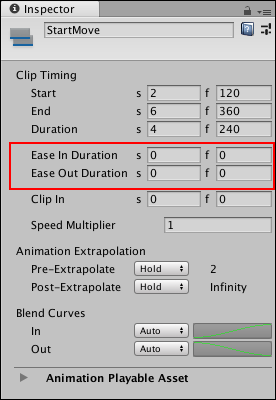
Ease-in and ease-out transitions create different effects, depending on the track:
On an Animation track or an Animation Override track, ease-in to an Animation clipAnimation data that can be used for animated characters or simple animations. It is a simple “unit” piece of motion, such as (one specific instance of) “Idle”, “Walk” or “Run”. More info
See in Glossary to create a smooth transition between the animation in the gap before the clip and the Animation clip. Ease-out of an Animation clip to create a smooth transition between the Animation clip and the animation in the gap after the clip. For information on the factors that determine what animation occurs in the gap before and after an Animation clip, see Setting gap extrapolation.On an Audio track, ease-in to an Audio clipA container for audio data in Unity. Unity supports mono, stereo and multichannel audio assets (up to eight channels). Unity can import .aif, .wav, .mp3, and .ogg audio file format, and .xm, .mod, .it, and .s3m tracker module formats. More info
See in Glossary to fade in the volume of the audio waveform. Ease-out of an Audio clip to fade out the volume of the audio waveform specified by the Audio clip.On a Playable track, ease-In to a Playable clip to fade in the effect or script in the Playable clip. Ease-out of a Playable clip to fade out the effect or script in the Playable clip.

Although the Clips viewThe area in the Timeline Editor window where you add, position, and manipulate clips. More info
See in Glossary represents an ease-in or ease-out transition as a single linear curve, every ease-in or ease-out transition is actually set to a gradually easing-in or easing-out curve by default. To change the shape of either the ease-in curve (labelled In) or the ease-out (labelled Out) curve, use the Blend Curves in the Inspector window.
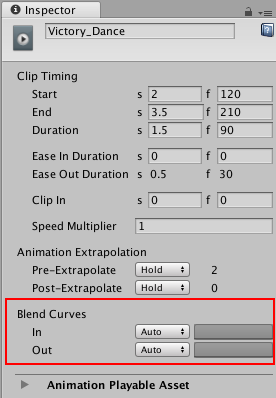
Note that the Blend Curves might affect the blend areaThe area where two Animation clips, Audio clips, or Control clips overlap. The overlap creates a transition that is referred to as a blend. The duration of the overlap is referred to as the blend area. The blend area sets the duration of the transition. More info
See in Glossary used for blending between two clips. The Ease In Duration and Ease Out Duration properties indicate whether the Blend Curves affect an ease-in or ease-out transition, or a blend. For example, If the Ease Out Duration is editable, then the Blend Out curveIn a blend between two Animation clips, Audio clips, or Control clips, there are two blend curves. The blend curve for the out-going clip is referred to as the Blend Out curve. More info
See in Glossary (labelled Out) affects the curve used by an ease-out transition. If the Ease Out Duration is not editable, then the Blend Out curve (labelled Out) affects the outgoing clip in a blend between two clips.

To customize either the ease-in or ease-out transition, use the drop-down menu to switch from Auto to Manual. With Manual selected, the Inspector window shows a preview of the blend curve. Click the curve preview to open the Curve Editor below the Inspector window.
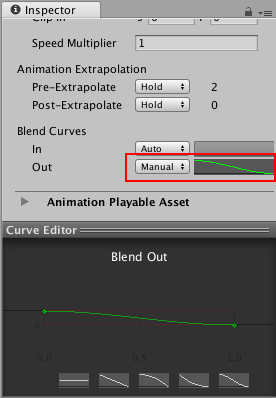
The Curve Editor is the same editor that is used to customize the shape of the blend curves when blending between clips.
When creating an ease-in or an ease-out transition with Animation clips, the Animation clip blends between its gaps and the Animation clip. The following factors affect the values of animated properties in the gaps surrounding an Animation clip:
The pre-extrapolate and post-extrapolate settings for the Animation clip and for other Animation clips on the same track.
Animation clips on other Animation tracks that are bound to the same GameObjectThe fundamental object in Unity scenes, which can represent characters, props, scenery, cameras, waypoints, and more. A GameObject’s functionality is defined by the Components attached to it. More info
See in Glossary.The position or animation of the GameObject in the SceneA Scene contains the environments and menus of your game. Think of each unique Scene file as a unique level. In each Scene, you place your environments, obstacles, and decorations, essentially designing and building your game in pieces. More info
See in Glossary, outside the Timeline AssetRefers to the tracks, clips, and recorded animation that comprise a cinematic, cut-scene, game-play sequence, or other effect created with the Timeline Editor window. A Timeline Asset does not include bindings to the GameObjects animated by the Timeline Asset. The bindings to scene GameObjects are stored in the Timeline instance. The Timeline Asset is Project-based. More info
See in Glossary.
Gap extrapolation and easing clips
To successfully ease-in or ease-out an Animation clip, gap extrapolation must not be set based on the Animation clip being eased-in or eased-out. Gap extrapolationHow an Animation track approximates animation data in the gaps before and after an Animation clip. More info
See in Glossary must either be set to None or set by another Animation clip.
For example, the following ease-in transition has no effect because the Pre-Extrapolate for the Victory_Dance clip is set to Hold. This means that the ease-in creates a transition between the first frame of the Animation clip and the rest of the Animation clip.
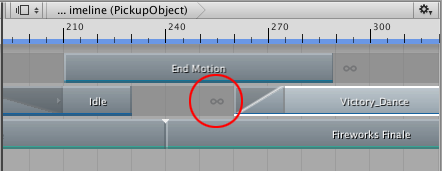

Overriding Animation tracks with ease-in and ease-out transitions
Use two Animation tracks bound to the same GameObject to create a smooth transition between two Animation clips.
For example, if two Animation tracks are bound to the same GameObject and a clip on the second track contains an ease-in transition, the ease-in transition creates a smooth transition between the animation on the previous track and the animation on the second track.
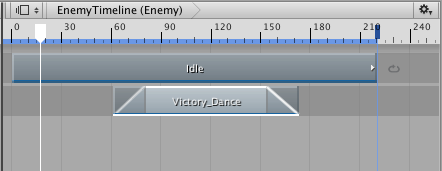
In this example, the Animation clip on the first track is a repeated idle cycle where the humanoid GameObject stands still. The Animation clip in the second track eases-in the Victory_Dance motion and eases-out to return back to the idle cycle
To successfully override animation on a previous track, the gap extrapolation for the second track must be set to None so that the animation data in the gap is taken from the previous track bound to the same GameObject. The ease-in and ease-out transitions use this animation data.
- 2019–08–20 Page published